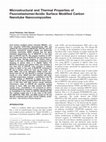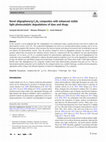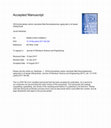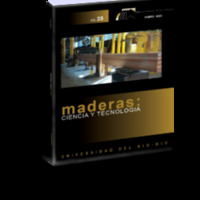Papers by Javad Heidarian
Industrial & Engineering Chemistry Research, Jul 28, 2004
The effects of the mixing rate and temperature on foaming are investigated, and the time minimiza... more The effects of the mixing rate and temperature on foaming are investigated, and the time minimization for the polyamidation reaction in the presence of catalyst in a semibatch reactor to prevent foaming was performed using the MATLAB program. The process constraints ...

Polimeros-ciencia E Tecnologia, Aug 1, 2015
Acid surface modified carbon nanotube (MCNT)-, Carbon nanotube (CNT)-filled fluoroelastomer (FE) ... more Acid surface modified carbon nanotube (MCNT)-, Carbon nanotube (CNT)-filled fluoroelastomer (FE) and unfilled-FE were prepared (MCNT/FE, CNT/FE and FE). The compounds were subjected to thermogravimetric analysis (TGA) and heat air aging, and characterized by Energy Dispersive X-Ray (EDX). Results showed that MCNT improved the thermal properties of FE, resulting in a larger amount of FE and char remaining in the temperature range of 400-900 °C relative to unfilled FE and CNT/FE. The MCNT/FE TGA curve shifted towards higher temperatures compared to CNT/FE and FE. The same results also revealed that higher percentages of FE were undegraded or less degraded especially near MCNT in the temperature range of 400-540 °C. Energy Dispersive X-Ray (EDX) results indicated that the percentage of carbon and fluorine in the residue of TGA scans, up to 560 °C, of MCNT/FE were the same as CNT/FE, and were higher than FE. EDX results of TGA residue (run up to 900 °C) showed that most of the undegraded FE, which was not degraded at temperatures below 560 °C, was degraded from 560 °C to 900 °C in both MCNT/FE and CNT/FE, with the char in MCNT/FE being more than that in CNT/FE. EDX analysis of thermal aged specimens under air showed that, with increasing aging time, a greater percentage of C, O and F was lost from the surface of filler/FE and FE. The order of element loss after 24 hour aging time was: MCNT/FE > FE > CNT/FE.

Composite Interfaces, Jan 5, 2016
Abstract Nanocomposites were prepared using carbon nanotubes (CNTs) in the formulations of fluoro... more Abstract Nanocomposites were prepared using carbon nanotubes (CNTs) in the formulations of fluoroelastomer (FE). Thermogravimetric analysis (TGA) results revealed that CNT improved the thermal properties of FE, resulting in higher amount of FE and char remaining within the temperature range of 520–900 °C, relative to unfilled FE and carbon black (CB)-filled FE. The same results also revealed that more percentage of FE was undegraded or less degraded especially near CNT. Energy dispersive X-ray (EDX) results indicated that the percentage of carbon and fluorine in the residue of TGA scans up to 560 °C of CNT-filled FE (CNT/FE) were higher compared to the CB-filled FE (CB/FE), and CB/FE was higher than FE. EDX results of TGA residue (run up to 900 °C) showed that most of the undegraded FE which was not degraded at temperatures below 560 °C was degraded from 560 °C to 900 °C in both CNT/FE and CB/FE, with the char in CNT/FE being more than that in CB/FE. Residue of samples after TGA scans up to 900 °C indicated that, Zn did not undergo any reaction with CNT in the CNT/FE. In CB/FE, some percentage of ZnO reacted with carbon. EDX analysis of thermal aged specimens under air showed that with increasing aging time, more percentage of C, O, and F were lost from the surface of filler/FE and FE. The order of element loss is: CNT/FE < FE < CB/FE.

Polymer Composites, May 7, 2015
Acid surface modified carbon nanotube (MCNT)-, carbon nanotube (CNT)-filled fluoroelastomer (FE),... more Acid surface modified carbon nanotube (MCNT)-, carbon nanotube (CNT)-filled fluoroelastomer (FE), and unfilled-FE were prepared (MCNT/FE, CNT/FE, and FE). Dynamic mechanical analysis (DMA) and differential scanning calorimetry (DSC) showed that the glass transition temperature (T g) of MCNT/FE is less than that of CNT/FE and FE. The storage modulus of CNT/ FE is higher than that of MCNT/FE over the whole temperature range. Storage modulus in rubbery state is higher in the case of MCNT/FE when compared to FE, however, in glassy state, it is slightly higher. For MCNT/FE at glassy and rubbery state, loss modulus is less than that of CNT/FE. Loss modulus in rubbery states is higher in the case of MCNT/FE compared to FE and in glassy states for both are the same. The DSC, DMA, and X-ray diffraction (XRD) results confirmed that the FE and filler/FE is partially crystalline mostly in c-form. MCNT and CNT together with shear and high temperature, induced c-crystallinity in the FE, c-phase melting of MCNT/FE is higher than that of CNT/FE and FE. Most probably MCNT/FE obeys behaviors of thin films with high surface energy substrate interactions, while in CNT/FE the substrate surface energy is lower. XRD and DSC showed that MCNT causes more c-crystallinity in FE compared to others. Tetrafluoroethylene segments crystals have the degree of crystallinity in the order of CNT/FE > MCNT/FE > FE. The c-phase crystal size is in the order of FE > CNT/ FE > MCNT/FE. XRD, DSC, and DMA results for FE and filler/FE confirmed each other.
• Viton: a synthetic rubber, a fluoroelastomer from Du Pont, USA • Viton® GF-600S: latest develop... more • Viton: a synthetic rubber, a fluoroelastomer from Du Pont, USA • Viton® GF-600S: latest development in Viton GF family • Viton® GF-600S: terpolymer of hexafluoropropylene, vinylidene fluoride, and tetrafluoroethylene with a cure site monomer • Viton® GF-600S, peroxide cure, 70% fluorine fluoroelastomer, new Advanced Polymer Architecture Introduction • Viton (FE) formulation: carbon black (CB) filled • Replacing CB with carbon nanotubes (CNT) • Using acid surface modified CNT (MCNT) is expected to improve the properties, even more than CNT • To improve the thermal, physical, mechanical, and chemical properties • To make O-rings for oil and gas industries
Polímeros, 2018
Glass fibre (GF), nanoclay (NC) and hybrid composites compatibilised with maleic anhydride polypr... more Glass fibre (GF), nanoclay (NC) and hybrid composites compatibilised with maleic anhydride polypropylene (MAPP) were prepared by extrusion and injection moulding. The fourier transform infra-red spectra revealed the characteristic absorption peaks of MAPP in the compatibilised GF and NC composites. A decrement in the peak intensity of X-ray diffraction patterns of NC composite was obtained as the MAPP content increased indicating a partial exfoliation of NC. The thermogravimetric analysis showed that the incorporation of MAPP into hybrid composites reduced the thermal stability of the material. The dynamic mechanical analysis showed an increase in the storage modulus in the hybrid composites with lower content of MAPP due to the enhancement in the interfacial adhesion between the GF, NC and PP matrix.

Al giorno d'oggi, il mantenimento della stabilita dei pozzi e un'attivita molto important... more Al giorno d'oggi, il mantenimento della stabilita dei pozzi e un'attivita molto importante nell'industria della perforazione. La stabilita dei pozzi puo essere migliorata progettando un adeguato fluido di perforazione. A causa delle caratteristiche delle formazioni di scisto in relazione alla sua composizione ionica, al contenuto di argilla e alla permeabilita molto bassa di Nano-Darcy con gole a pori molto piccoli di dimensioni nanometriche che non sono efficacemente sigillate dai solidi nei fluidi di perforazione convenzionali, l'invasione dell'acqua a questi tipi di formazioni comporta molti problemi. La scelta di nanomateriali appropriati con dimensioni e concentrazioni di particelle adatte per tappare i pori di dimensioni nanometriche nelle formazioni scistose e fondamentale per prevenire il flusso di acqua nella regione dello scisto. Le prestazioni dei fanghi a base d'acqua e le proprieta reologiche migliorano grazie all'importanza e alle proprieta ...

Journal of Elastomers & Plastics, 2021
Carbon nanotube (CNT)-, surface-modified CNT: acid (–COOH) modified (MCNT) or base (–OH) modified... more Carbon nanotube (CNT)-, surface-modified CNT: acid (–COOH) modified (MCNT) or base (–OH) modified (OHCNT), carbon black (CB)-filled fluoroelastomer (FE) and unfilled FE were prepared (CNT/FE, MCNT/FE, OHCNT/FE, CB/FE and FE). The thermal properties of the composites were assessed by TGA-GCMS and TGA and compared for all samples. TGA-GCMS results show that degradation products that obtained due to breakage of the CF2-CH2 bond (group A) and CF2-CF2 bond (group B) in base FE, obtained in lower temperatures and higher temperatures of TGA scan respectively, therefore CF2-CF2 bond is more thermally stable than CF2-CH2. For degradation products of group A and group B, the relative abundance decreased in the following orders respectively for all samples: CB/FE, CNT/FE, OHCNT/FE, FE, MCNT/FE; and MCNT/FE, OHCNT/FE, FE, CNT/FE, CB/FE. Therefore nanofillers and particularly surface-modified nanofillers produce less amount of group A degradation products and more amount of group B degradation p...

Environmental Science and Pollution Research, 2020
In this research, a novel graphene-like SiC (siligraphene) was synthesized using a natural precur... more In this research, a novel graphene-like SiC (siligraphene) was synthesized using a natural precursor and used to improve the photocatalytic activity of g-C 3 N 4. The synthesized siligraphene has shown an excellent photocatalytic property due to its low band-gap and graphene-like structure which increases the electron transfer and reduces the electron-hole recombination rate and can improve the photocatalytic activity. Also, the positive charged Si atoms in siligraphene structure can adsorb oxygen to produce radicals that can promote the oxidation reaction. However, commercial β-SiC has exhibited very poor photocatalytic properties. As we know, g-C 3 N 4 is a potential material for photocatalytic applications. Here, the novel siligraphene/g-C 3 N 4 composites were successfully synthesized to enhance the photocatalytic properties of g-C 3 N 4 in the degradation of model dyes (Congo red, Methyl red, and Methyl orange) and model drugs (Acetaminophen and Tetracycline) under visible light irradiation. Results show that siligraphene/g-C 3 N 4 composite exhibits much better photocatalytic properties than pure g-C 3 N 4. This enhanced photocatalytic properties can be justified by the enlarged surface area, suitable band gap, excellent electron properties, appropriate surface charge, and efficient migration of electron in siligraphene/g-C 3 N 4 composite.

International Journal of Petrochemical Science & Engineering, 2019
High hardness Flouroelastomers (copolymer of ethylene-tetrafluoroethylene-perfluoro methyl vinyl ... more High hardness Flouroelastomers (copolymer of ethylene-tetrafluoroethylene-perfluoro methyl vinyl with Advanced Polymer Architecture) compound was used to make thick and large size O-rings and field tested in pipeline valves containing very sour gas. The sour gas contains 23% H2S, 11% CO2, CH4, low molecular weight hydrocarbons, amine corrosion inhibitors, methanol and water at 32°C and 1200 psi. The results show that after the field test these O-rings were in good conditions and were completely resistance to sour gas and no cracks, bubble, blister, swelling, hardening and softening in the O-rings were observed and they were resistant against the H2S, methanol, amine corrosion inhibitors and steam. High pressure of the system did not produce any defects due to explosive decompression phenomenon or did not cause extrusion in these O-rings. A lower hardness compound also were used to prepare small size and thin O-rings, after O-rings test in very sour gas pipelines valves they were in ...

Polimery, 2018
Wykonano badania reometryczne polimerowego kompozytu drzewnego (WPC) na osnowie polipropylenu (PP... more Wykonano badania reometryczne polimerowego kompozytu drzewnego (WPC) na osnowie polipropylenu (PP) z udziałem 50 % mas. mączki drzewnej. Przedstawiono procedury wyznaczania krzywych lepkości WPC na podstawie ograniczonej liczby pomiarów wskaźnika szybkości płynięcia (MFR), z zastosowaniem uniwersalnego równania Vinogradova-Malkina, dwuparametrowego równania potęgowego Ostwalda-de Waele oraz trójparametrowego równania logarytmicznego Kleina. Przeprowadzono badania plastometryczne WPC, na podstawie których wyznaczono krzywe lepkości. Stwierdzono, że proponowane rozwiązania mogą być przydatne w praktyce inżynierskiej do szybkiej oceny właściwości reologicznych polimerowych kompozytów drzewnych. Słowa kluczowe: polimerowe kompozyty drzewne, lepkość, reometria. Determination of viscosity curves of wood polymer composites based on limited rheological measurements Abstract: Rheological studies of wood polymer composite (WPC) with polypropylene (PP) matrix containing 50 wt % wood flour have been performed. Several procedures for determination of WPC viscosity curves with a limited number of melt flow rate (MFR) measurements using universal Vinogradov-Malkin, two-parameter Ostwald-de Waele power-law and three-parameter logarithmic Klein equations were presented. The plastometric tests of WPC were carried out to determine the viscosity curves. It has been stated that the discussed procedures can be useful in engineering practice to rapidly assess the rheological properties of wood polymer composites.

Journal of Petroleum Science and Engineering, 2017
OH-functionalized carbon nanotube (BCNT)-, carbon nanotube (CNT)-filled fluoroelastomer (FE) and ... more OH-functionalized carbon nanotube (BCNT)-, carbon nanotube (CNT)-filled fluoroelastomer (FE) and unfilled-FE compounds were prepared (BCNT/FE, CNT/FE and FE). The oil based drilling mud (OBD mud) aging resistances of these elastomers were assessed by tests of AFM, weight gain, swelling and optical microscopy and EDX elemental analysis (to determine the elements of C, O, F, Si and Ca). The following results were obtained when the above mentioned test results for FE-OBD (OBD mud tested FE) were compared to those of FE: The roughness and average height of surface decreased considerably (approximately-42% and-37%, respectively). Defects appeared on the surface. The swelling was negative and significant (nearly-15.7%). The surface was full of cracks. A considerable amount of fluorine was lost from the surface (Wt%: 32.0%). The following results were obtained when the before mentioned test results for BCNT/FE-OBD and CNT/FE-OBD compared to those of BCNT/FE and CNT/FE respectively: The changes in AFM results were minor. There were no defects on the surfaces. The swelling was low (approximately 5.7% and 4.1%, respectively). There were no cracks on the surfaces. Nanocomposites did not lose fluorine from the surface (Wt%: roughly 10.3% and 7.3%, respectively). Therefore, BCNT/FE and CNT/FE are resistant to OBD mud and can be used as sealing rubbers (for example o-rings) in OBD drilling for oil and gas. In contrast the original FE compound cannot be used.

Journal of Elastomers & Plastics, 2017
Acid surface–modified carbon nanotube (ACNT)-, carbon nanotube (CNT)-filled fluoroelastomer (FE),... more Acid surface–modified carbon nanotube (ACNT)-, carbon nanotube (CNT)-filled fluoroelastomer (FE), and unfilled-FE compounds were prepared (ACNT/FE, CNT/FE, and FE). The oil-based drilling (OBD) mud aging resistances of these elastomers were assessed by tests of weight gain, swelling, atomic force microscopy (AFM), and optical microscopy. The results show that for ACNT/FE-OBD (OBD mud tested ACNT/FE) and CNT/FE-OBD, there are no blisters, cracks, swellings, and deformed or uneven surfaces; however, for FE-OBD surfaces, these defects exist. ACNT/FE-OBD and CNT/FE-OBD have very low swelling, while for FE-OBD, the swelling is negative which indicates OBD chemical degradation of FE-OBD. All samples under study show low weight gain. AFM results show that roughness and average height of FE-OBD surface decreased considerably compared to that of FE. However, the changes in AFM results of ACNT/FE-OBD and CNT/FE-OBD compared to ACNT/FE and CNT/FE, respectively, are minor. ACNT/FE-OBD has a rou...

Polish Journal of Chemical Technology, 2017
Carbon nanotube (CNT)-, carbon black (CB)-filled fluoroelastomer (FE) and unfilled-FE compounds w... more Carbon nanotube (CNT)-, carbon black (CB)-filled fluoroelastomer (FE) and unfilled-FE compounds were prepared (CNT/FE, CB/FE and FE). The compounds were subjected to heat air aging and characterized by tensile test and X-Ray Diffraction (XRD) analysis. Results show that CNT improved tensile properties of FE before and after aging. All samples show stress induced crystallization (SIC) during tension. XRD results show that under all conditions, the crystals were in the form of γ-phase. For both aged and un-aged specimens, the degree of crystallinity (Xc) is low. After tensile stretching, Xc of un-aged specimens increases tremendously, with larger crystal size. Under the same conditions, the order of elongation at break (EL) was FE > CB/FE > CNT/FE. Normal modulus (NM) and tangent modulus (TM) at the same conditions was in the order of CNT/FE > CB/FE > FE. Tensile strength had the order of CNT/FE > CB/FE > FE.

Asian Journal of Chemistry, 2015
Viton is a synthetic rubber and a fluoroelastomer (FE). Viton® GF-600S is a terpolymer of hexaflu... more Viton is a synthetic rubber and a fluoroelastomer (FE). Viton® GF-600S is a terpolymer of hexafluoro-propylene, vinylidene fluoride and tetra-fluoroethylene with a cure site monomer. It is a peroxide cure and 70 % fluorine fluoroelastomer. Normally, in the formulation of fluoroelastomer, carbon black is used. Replacing carbon black with carbon nanotube partially or totally is expected to improve properties of fluoroelastomer which are important in making O-rings, especially for oil and gas industries. The thermal decomposition properties of fluoroelastomers and polytetrafluoroethylene (PTFE) have been examined by Lee. Heating rates of 2°-30 °C/min under a static air atmosphere were employed for the experiments. The decomposition of fluoroelastomers occurs from 400° to 500 °C and PTFE decomposed at a higher temperature (500° to 600°C). The activation energies of decomposition, for the two fluoroelastomers and fluorocarbon resin, ranged from 225 to 266 kJ mol. The surface morphology of the fluoropolymers after a heat-treatment procedure shows that there were no changes in the morphology when the heat-treatment temperature was under 400 °C for 10 min. However, both fluoropolymers decomposed when the heat-treatment temperature was 500 °C for 10 min. Improving Thermal Properties of Fluoroelastomer Using Carbon Nanotubes in Presence of Air and Under Nitrogen Flow
Journal of Reinforced Plastics and Composites, 2012
Red Balau saw dust was heat-treated at 180°C and 200°C for 1 h. Treated and untreated wood flour ... more Red Balau saw dust was heat-treated at 180°C and 200°C for 1 h. Treated and untreated wood flour were compounded with LDPE at 9%, 20%, and 37% by weight and molded in an injection molding machine. Thermal and mechanical properties of the resultant composites were investigated as a function of filler loadings and treatment temperature. Thermogravimetric analysis revealed an increase in degradation peak temperature ( Tp) of the heat-treated wood and composites. DSC revealed a decreasing trend in the degree of crystallinity ( Xc) of the matrix when heat-treated wood was used as filler. On the other hand, untreated wood showed an increase in Xc with increasing wood content. Tensile modulus increased with heat treatment and filler loading. Furthermore, flexural strength and modulus were found to increase with filler loading.
Journal of Applied Sciences, 2010











Uploads
Papers by Javad Heidarian